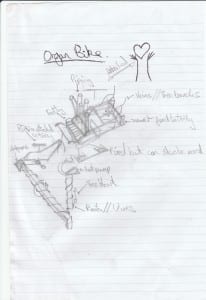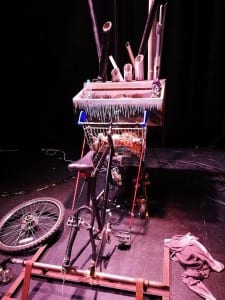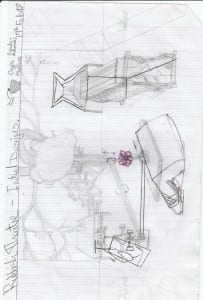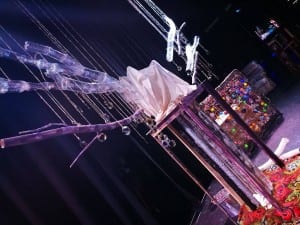Working with little to no budget has been a challenge, but it has also enabled me, as a designer, to explore and push the boundaries of what a set can be made out of. Seeing old bits of rubbish and my initial drawings and designs be transformed into our set on the day of our performance, 22nd May 2017, was just unbelievable. What is most gratifying is seeing a through line from my first designs to the finished product, my vision was complete.
(IMAGE OF SET ON SHOW DAY)
(Image taken by Pearson, J. on Monday 22nd May 2017.
Rubbish Theatre, 2017)
The hour long installation process before the show began was a beautiful moment; it enabled the audience, the ensemble and set to all become immersed in the world of, If an Orchid Was All You Had. It gave the audience the opportunity to engage with the set and see the finer details (the filling of the memory boxes, the sewing of flowers in the garden and the makings of the world). Tina Bicat states that, ‘The setting in which the performers play their pars is the first thing that the audience sees, and helps their understanding of, and involvement in, the show. It gives people confidence that their interpretation is on the right lines’ (Bicat, 2012, 10). Giving the audience a chance to see the setting before the show starts then gave room for greater understanding and involvement with our show. The space in which we were performing became a whole new space, where performer, audience and set can co-exist and be immersed.
The set came together better than expected and helped produce the well-received show on Monday night. I do feel, however, there could have been some improvements or changes to the set – improvements that can easily be implemented if the show was to be performed again. This is the beauty of working with rubbish, the set can constantly change and develop, without any knock to the budget.
The first would be to create an easier, efficient system for the tree branches to bleed blood, as the effect was lost on the night. The second would be the positioning of the bike, and seeing how the audience’s connection with The Man could change based on the direction he is facing or the placement on stage – a more centralised, outwards facing setup could be more effective. The final change would be to make the contents of the memory boxes more visible, as I feel any audience member who missed the installation may not have noticed what was inside.
References:
Bicat, T. (2012) Costume and Design for Devised and Physical Theatre. Marlborough: The Crowood Press Ltd.
Rubbish Theatre. (2017) If an Orchid Was All You Had. [Performance] Jacob Kay (dir.) Lincoln: Lincoln Performing Arts Centre, 22nd May.




